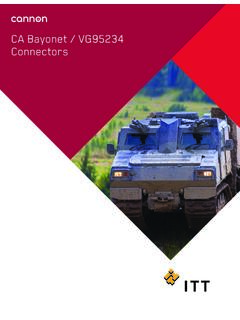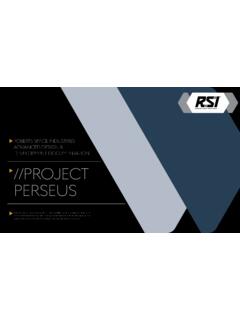Transcription of YOLO-Z: Improving small object detection in YOLOv5 for ...
1 YOLO-Z: Improving small object detection in YOLOv5 forautonomous vehiclesAduen Benjumea*Izzeddin Teeti Fabio Cuzzolin Andrew autonomous vehicles and autonomous racing rise in popularity, so does the need for faster and more accuratedetectors. While our naked eyes are able to extract contextual information almost instantly, even from far away,image resolution and computational resources limitations make detecting smaller objects (that is, objects that occupya small pixel area in the input image) a genuinely challenging task for machines and a wide-open research field. Thisstudy explores how the popular YOLOv5 object detector can be modified to improve its performance in detectingsmaller objects, with a particular application in autonomous racing.
2 To achieve this, we investigate how replacingcertain structural elements of the model (as well as their connections and other parameters) can affect performanceand inference time. In doing so, we propose a series of models at different scales, which we name YOLO-Z , andwhich display an improvement of up to in mAP when detecting smaller objects at 50% IOU, at the cost ofjust a 3ms increase in inference time compared to the original YOLOv5 . Our objective is to inform future researchon the potential of adjusting a popular detector such as YOLOv5 to address specific tasks and provide insights onhow specific changes can impact small object detection . Such findings, applied to the broader context of autonomousvehicles, could increase the amount of contextual information available to such IntroductionDetecting small objects in images can be challenging, mainly due to limited resolution and context information avail-able to a model [2].
3 Many modern systems that implement object detection do so at real-time speeds, setting specificrequirements in computational resources, especially if the processing is to happen on the same device that capturesthe images. This is the case for many autonomous vehicle systems [4], where the vehicle itself captures and processesimages in real-time, often to inform its next actions. In this context, detecting smaller objects means detecting objectsfarther away from the car, thus allowing earlier detection of such objects, effectively expanding the detection range ofthe vehicle . Improvements in this specific area would better inform the system, allowing it to make more robust andviable to the nature of object detectors, the details of smaller objects lose significance as they are processed by eachlayer of their convolutional backbone.
4 In this study, by small objects , we refer to objects which occupy a small pixelarea in the input have been made to improve the detection of smaller objects [19], but many revolve around directing the pro-cessing around a specific area of the image [29, 28, 27] or are focused around two-stage detectors, which are known forachieving better performance at the cost of inference time, making them less suited for real-time applications. This isalso the reason why so many single-stage detectors have been developed for this type of applications [31]. Increasingthe input image resolution is another obvious way to bypass this issue which results, however, in a significant increasein processing is a very popular single-stage object detector [11] known for its performance and speed with a clear andflexible structure that can be broken down, adjusted and built on a very widely accessible platform.
5 Many of thesystems that apply this architecture and attempt to optimise it, however, they mainly rely on adjusting specific param-eters or augmenting their training set to improve performance [33], without much consideration for structural changes*Visual Artificial Intelligence Laboratory, Oxford Brookes University, UK Autonomous Driving & Intelligent Transport Group, Oxford Brookes University, UK1 [ ] 3 Jan 2023to the model itself to better adapt it for a specific use case. While YOLOv5 is a potent tool, it is designed to be ageneral-purpose object detector and therefore is not optimised to detect smaller study proposes ways in which YOLOv5 can be modified to better perform on a given system in terms of smallobject detection , with clear real-world implications [4].
6 We consider, in particular, the case of an autonomous racingvehicle that needs to detect differently coloured cones to drive around a track. We will discuss the effects of differ-ent techniques and propose modified models able to perform this task better while maintaining real-time processingspeeds. The contributions of this paper are:1. A modified model of YOLOv5 specifically designed for better detections of small Proposing a methodology to modify the structure of YOLOv5 to improve performance in a particular task. Thisis done in an experimental manner, analysing the different elements that make Related workThis study aims at refining the already existing YOLOv5 model to deal with the many problems associated withsmall object detection .
7 This task is a complex area of machine learning that very quickly escalates in complexity asrequirements evolve. To work with such systems, it is essential to understand the bases upon which they are built, themany different technologies and techniques that form the current state of the art and the related use One-stage vs two-stage objects detectorsWe know we can classify object detectors into two categories: one-stage and two-stage detectors [19]. The lattertypically decomposes the detection task into (i) region proposal generation and (ii) classification, as is the case withFaster R-CNN and its predecessors [6, 5, 26]. While there have been efforts to improve the small object detectionability of such models [3], a lot of the attention has been put on performance regardless of inference time.
8 Two stagedetectors have however improved significantly over time by streamlining their structure and data The YOLO familyAs a family of object detectors, YOLO takes this idea a step further and has grown very popular over the last few YOLOv1 [23], object detection is presented as a regression task, thus simplifying the networks and allowing usto build faster models that can be used in real-time. Later versions of YOLO improve different aspects of the model[23, 24, 25, 1]. Most notably, much effort has been spent on the backbone through the different versions. This begsthe question: What potential is there still untapped if changes to an isolated element can have such an impact? YOLOv5 [11] was released very shortly after YOLOv4 [1]. Despite its name, the authors are not directly related,and there have been discussions on whether it is fair to call YOLOv5 a successor of YOLOv4.
9 This implementationprovides similar performance to YOLOv4 and shares the same design. The main point of attention is the fact that itis fully written in the PyTorch framework [20] as opposed to using any form of the Darknet framework [22] and hasa focus on accessibility and use in a wider range of development environments. Additionally, the models in YOLOv5prove to be significantly smaller, faster to train and more accessible to be used in a real-world Systems using and modifying YOLOv5 YOLO has been used in many applications requiring the detection of objects. In safety helmet detection systems[34], for instance, YOLO can be adjusted and implemented in series with the rest of a system. Similarly, face masksdetectors have been seen at the entrances of metro stations [33].
10 Both of these applications do a good job at exploitingthe benefits of YOLO for the detection of smaller objects [21], but do not go as far as modifying the systems that do make an effort to optimize YOLOv5 do so in a limited fashion. Once again, mask detectors [16]have been proposed that leverage anchors generated and data augmentation to fit a model to the use case better. Morecomplex systems for helmet detection [10] also do a great job at leveraging the contextual information around smallobjects to isolate them and facilitate their detection . However, their approach is not quite universally applicable andcomes at the cost of introducing a two-step adjustments to the internal structures of the model are surface-level. In a recent apple detection system [32],the backbone of YOLOv5 is slightly modified to simplify it, which offers the potential to adapt to the system s re-quirements and one that opens the way for additional changes.
![arXiv:0706.3639v1 [cs.AI] 25 Jun 2007](/cache/preview/4/1/3/9/3/1/4/b/thumb-4139314b93ef86b7b4c2d05ebcc88e46.jpg)

![arXiv:1301.3781v3 [cs.CL] 7 Sep 2013](/cache/preview/4/d/5/0/4/3/4/0/thumb-4d504340120163c0bdf3f4678d8d217f.jpg)
![@google.com arXiv:1609.03499v2 [cs.SD] 19 Sep 2016](/cache/preview/c/3/4/9/4/6/9/b/thumb-c349469b499107d21e221f2ac908f8b2.jpg)














